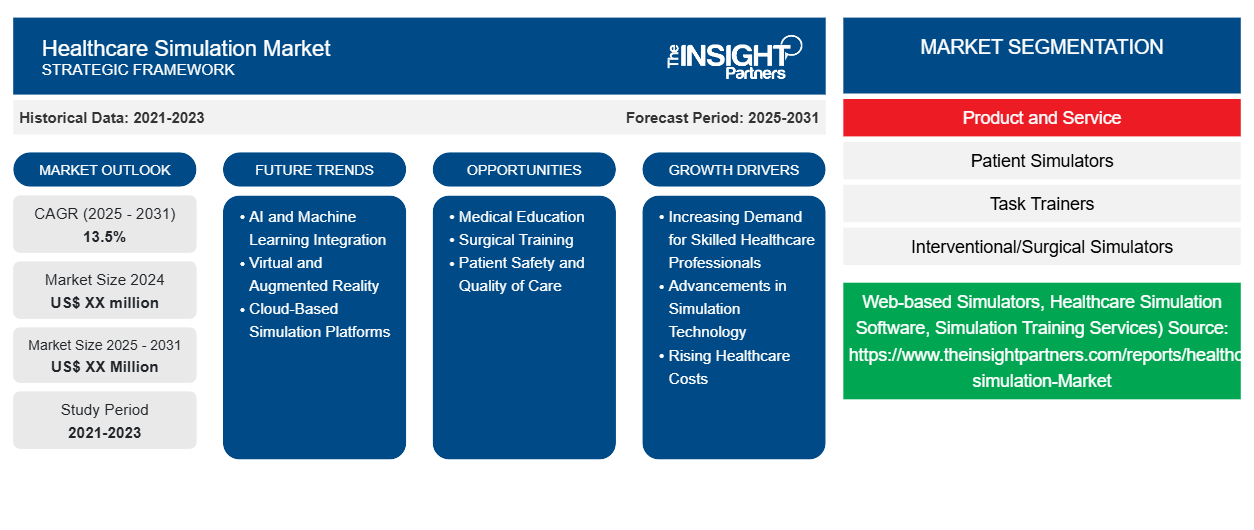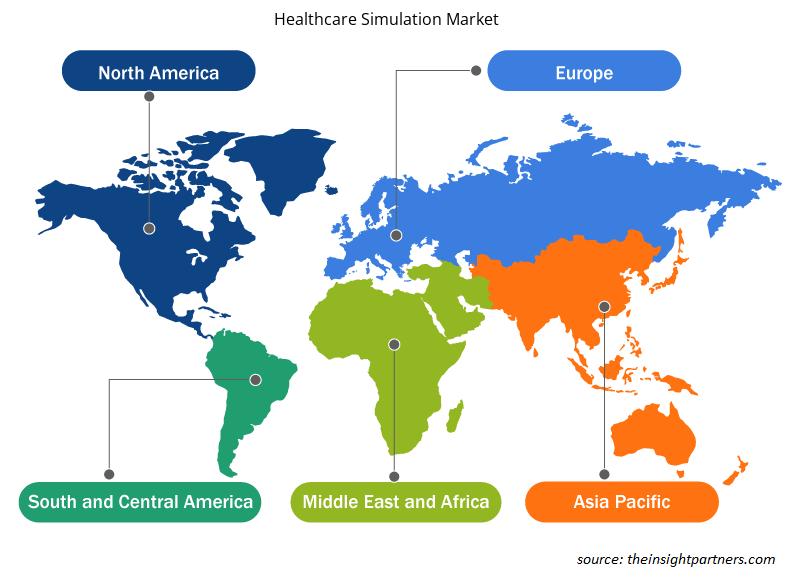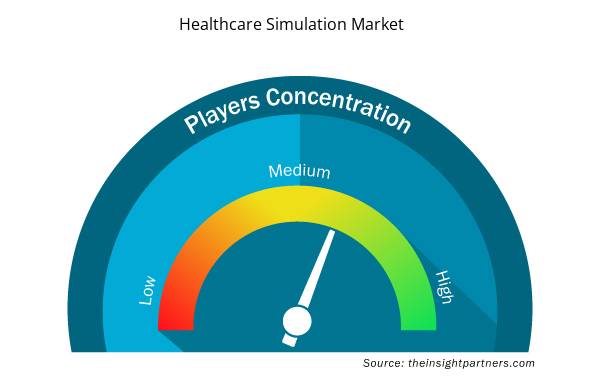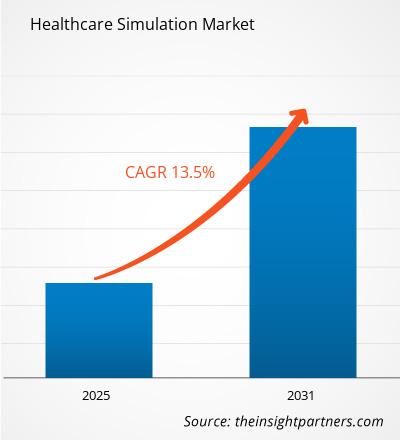The Healthcare Simulation Market is expected to register a CAGR of 13.5% from 2025 to 2031, with a market size expanding from US$ XX million in 2024 to US$ XX Million by 2031.
The report is divided into four sections: Product and Service (Patient Simulators, Task Trainers, Interventional/Surgical Simulators, Endovascular Simulators, Ultrasound Simulators, Dental Simulators, Eye Simulators), Web-based Simulators, Healthcare Simulation Software, and Simulation Training Services), Technology (3D Printing, Virtual Patient Simulation, Procedure Rehearsal Technology) and End User (Hospitals, Academic Institutes, Military Organizations, Others)
Purpose of the Report
The report Healthcare Simulation Market by The Insight Partners aims to describe the present landscape and future growth, top driving factors, challenges, and opportunities. This will provide insights to various business stakeholders, such as:
- Technology Providers/Manufacturers: To understand the evolving market dynamics and know the potential growth opportunities, enabling them to make informed strategic decisions.
- Investors: To conduct a comprehensive trend analysis regarding the market growth rate, market financial projections, and opportunities that exist across the value chain.
- Regulatory bodies: To regulate policies and police activities in the market with the aim of minimizing abuse, preserving investor trust and confidence, and upholding the integrity and stability of the market.
Healthcare Simulation Market Segmentation
Product and Service
- Patient Simulators
- Task Trainers
- Interventional/Surgical Simulators
- Endovascular Simulators
- Ultrasound Simulators
- Dental Simulators
- Eye Simulators
Web-based Simulators, Healthcare Simulation Software, Simulation Training Services) Source: https://www.theinsightpartners.com/reports/healthcare-simulation-Market
Technology
- 3D Printing
- Virtual Patient Simulation
- Procedure Rehearsal Technology
End User
- Hospitals
- Academic Institutes
- Military Organizations
- Others
Customize This Report To Suit Your Requirement
You will get customization on any report - free of charge - including parts of this report, or country-level analysis, Excel Data pack, as well as avail great offers and discounts for start-ups & universities
Healthcare Simulation Market: Strategic Insights

- Get Top Key Market Trends of this report.This FREE sample will include data analysis, ranging from market trends to estimates and forecasts.
Healthcare Simulation Market Growth Drivers
- Increasing Demand for Skilled Healthcare Professionals: A growing global population and aging demographics require a well-trained healthcare workforce.
- Advancements in Simulation Technology: The development of realistic and immersive simulation technologies enhances training effectiveness.
- Rising Healthcare Costs: Simulation-based training can reduce costs associated with traditional training methods like live patient training.
Healthcare Simulation Market Future Trends
- AI and Machine Learning Integration: AI and ML will personalize training experiences and provide real-time feedback.
- Virtual and Augmented Reality: VR and AR will create highly immersive and realistic simulation environments.
- Cloud-Based Simulation Platforms: Cloud-based platforms will enable remote access and collaborative training.
Healthcare Simulation Market Opportunities
- Medical Education: Simulation can enhance medical education by providing hands-on training in a safe and controlled environment.
- Surgical Training: Advanced surgical simulations can improve surgical skills and reduce medical errors.
- Patient Safety and Quality of Care: By improving healthcare provider skills, simulation can contribute to better patient outcomes.
Healthcare Simulation Market Regional Insights
The regional trends and factors influencing the Healthcare Simulation Market throughout the forecast period have been thoroughly explained by the analysts at Insight Partners. This section also discusses Healthcare Simulation Market segments and geography across North America, Europe, Asia Pacific, Middle East and Africa, and South and Central America.

- Get the Regional Specific Data for Healthcare Simulation Market
Healthcare Simulation Market Report Scope
| Report Attribute | Details |
|---|---|
| Market size in 2024 | US$ XX million |
| Market Size by 2031 | US$ XX Million |
| Global CAGR (2025 - 2031) | 13.5% |
| Historical Data | 2021-2023 |
| Forecast period | 2025-2031 |
| Segments Covered |
By Product and Service
|
| Regions and Countries Covered | North America
|
| Market leaders and key company profiles |
Healthcare Simulation Market Players Density: Understanding Its Impact on Business Dynamics
The Healthcare Simulation Market market is growing rapidly, driven by increasing end-user demand due to factors such as evolving consumer preferences, technological advancements, and greater awareness of the product's benefits. As demand rises, businesses are expanding their offerings, innovating to meet consumer needs, and capitalizing on emerging trends, which further fuels market growth.
Market players density refers to the distribution of firms or companies operating within a particular market or industry. It indicates how many competitors (market players) are present in a given market space relative to its size or total market value.
Major Companies operating in the Healthcare Simulation Market are:
- CAE Inc.
- 3D Systems
- Laerdal
- Gaumard Scientific
- Limbs & Things
Disclaimer: The companies listed above are not ranked in any particular order.

- Get the Healthcare Simulation Market top key players overview
Key Selling Points
- Comprehensive Coverage: The report comprehensively covers the analysis of products, services, types, and end users of the Healthcare Simulation Market, providing a holistic landscape.
- Expert Analysis: The report is compiled based on the in-depth understanding of industry experts and analysts.
- Up-to-date Information: The report assures business relevance due to its coverage of recent information and data trends.
- Customization Options: This report can be customized to cater to specific client requirements and suit the business strategies aptly.
The research report on the Healthcare Simulation Market can, therefore, help spearhead the trail of decoding and understanding the industry scenario and growth prospects. Although there can be a few valid concerns, the overall benefits of this report tend to outweigh the disadvantages.
- Historical Analysis (2 Years), Base Year, Forecast (7 Years) with CAGR
- PEST and SWOT Analysis
- Market Size Value / Volume - Global, Regional, Country
- Industry and Competitive Landscape
- Excel Dataset


- Long Read Sequencing Market
- Authentication and Brand Protection Market
- Advanced Planning and Scheduling Software Market
- Nurse Call Systems Market
- HVAC Sensors Market
- Predictive Maintenance Market
- Bio-Based Ethylene Market
- Joint Pain Injection Market
- Adaptive Traffic Control System Market
- Clear Aligners Market

Report Coverage
Revenue forecast, Company Analysis, Industry landscape, Growth factors, and Trends

Segment Covered
Product and Services, Technology, End-user, and Geography

Regional Scope
North America, Europe, Asia Pacific, Middle East & Africa, South & Central America

Country Scope
This text is related
to country scope.
Frequently Asked Questions
Some of the customization options available based on request are additional 3-5 company profiles and country-specific analysis of 3-5 countries of your choice. Customizations are to be requested/discussed before making final order confirmation, as our team would review the same and check the feasibility.
The report can be delivered in PDF/PPT format; we can also share excel dataset based on the request.
The leading players in the Healthcare Simulation Market are: Alpine Electronics, Inc., Clarion Company, Ltd., Continental AG, Delphi Automotive plc, Denso Corporation, Garmin, Ltd., Harman International Industries, Inc., Panasonic Corporation, Robert Bosch GmbH, Visteon Corporation
Healthcare Simulation Market is expected to grow at a CAGR of 13.5% between 2023-2031
The future trends of the Healthcare Simulation Market are: Artificial Intelligence (AI), Remote and Virtual Simulation
The driving factors impacting the Healthcare Simulation Market are: Increasing Emphasis on Patient Safety, Advancements in technology
Trends and growth analysis reports related to Technology, Media and Telecommunications : READ MORE..
The List of Companies
1. CAE Inc.
2. 3D Systems
3. Laerdal
4. Gaumard Scientific
5. Limbs & Things
6. Mentice
7. Kyoto Kagaku Co., Ltd.
8. Intelligent Ultrasound
9. Simulab Corporation
10. Simulaids
11. Operative Experience, Inc.
12. Surgical Science
13. Cardionics, Inc.
14. VirtaMed
15. SYNBONE

 Get Free Sample For
Get Free Sample For